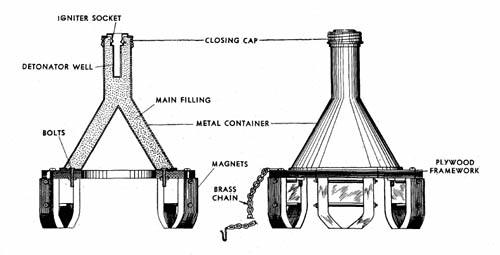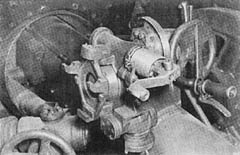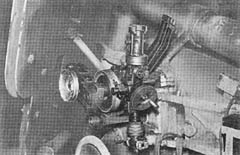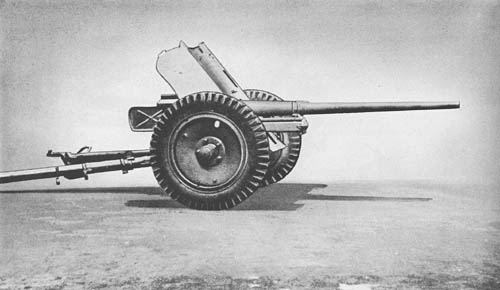
The Pak 41 first appeared in the European Theater of Operations in 1942. It is the second of the German tapered-bore antitank guns. The monobloc barrel is long, with marked external as well as internal taper. There is no muzzle brake. The breechblock is of the horizontal sliding wedge type opening to the left. There is no provision for automatic opening; it is manually opened by means of the operating handle situated on top of the breech ring. The firing mechanism is a combination percussion inertia type.
The recoil mechanism of the hydro-spring constant type is similar in construction to the
The elevation and traverse mechanisms are both fitted to the left side of the upper carriage.
The piece is mounted on the 3.7 Pak carriage fitted with sheet-metal, pneumatic-tired wheels, with tubular trails approximately 7 feet, 3 inches long. A light, steeply sloping, spaced armor shield is also provided.
A curved arm, riveted to the left side of the upper carriage, houses at its upper end the sight bracket trunnion from which the telescope carrier is hung.
Gerlich type ammunition, both H.E. and A.P., is used with the piece.
SPECIFICATIONS
| Caliber | 42/28 mm | ||||||||||||||||
| Weight | 1,360 lb. | ||||||||||||||||
| Rate of fire | 10-12 rds./min. | ||||||||||||||||
| Muzzle velocity | 4,101 f/s | ||||||||||||||||
| Weight of projectile (A.P.)* | .80 lb. | ||||||||||||||||
| Elevation | 19° | ||||||||||||||||
| Depression | -14° | ||||||||||||||||
| Traverse | 44° | ||||||||||||||||
| Penetration | |||||||||||||||||
|
|||||||||||||||||
| *This is a lightweight projectile consisting of a small tungsten carbide core embodied in a lightweight metal jacket. The jacket is so constructed that it is swaged to a smaller diameter as it moves through the tapered bore. This design permits a high muzzle velocity, but can be used for short ranges only as the velocity falls off rapidly. Penetration is accomplished by the core only, and because of its relatively small size very little damage is effected by it. | |||||||||||||||||
German: p. 128
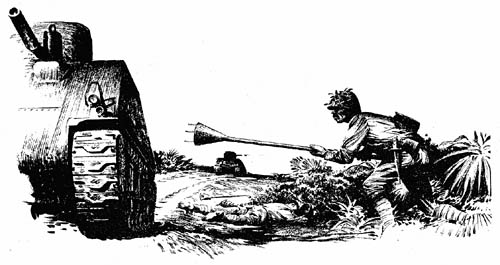
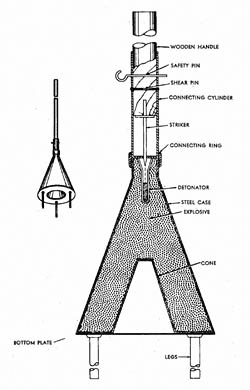 This suicide mine, an antitank device used by Japanese Close-quarter Combat Units, consists of a conical-shaped hollow charge encased in a steel container, and a wooden handle. Three legs equally spaced around the base of the charge provide proper stand-off distance. A well in the apex of the charge contains the detonator.
This suicide mine, an antitank device used by Japanese Close-quarter Combat Units, consists of a conical-shaped hollow charge encased in a steel container, and a wooden handle. Three legs equally spaced around the base of the charge provide proper stand-off distance. A well in the apex of the charge contains the detonator.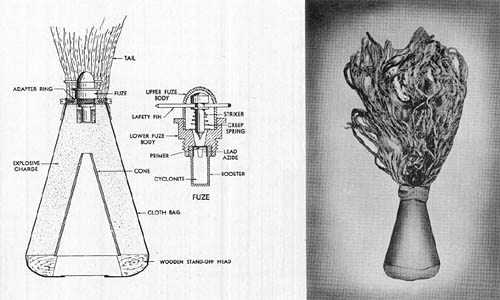
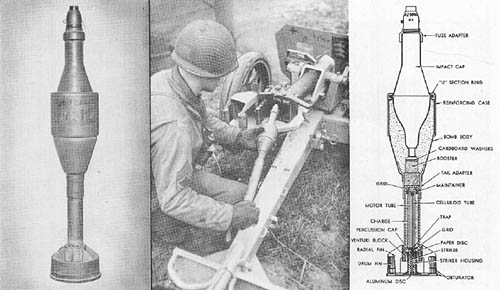
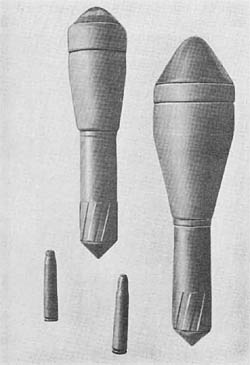 Two additional H.E.A.T. (hollow charge) armor piercing rifle grenades have recently been recovered and are illustrated herewith. They bear the designations
Two additional H.E.A.T. (hollow charge) armor piercing rifle grenades have recently been recovered and are illustrated herewith. They bear the designations 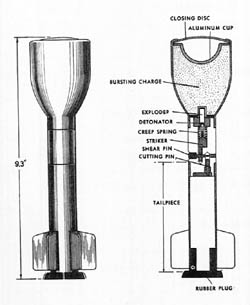 This grenade consists of a bell-shaped body of thin steel with a slightly convex aluminum closing disc, a graze fuze which screws into a cylindrical projection welded to the base of the body, and a finned tail unit. The bursting charge of cyclonite wax is cast around an aluminum hollow charge liner which is hemispherical in shape. A detonator and intermediary exploder are contained in an aluminum magazine which fits into the base of the main explosive cavity. The tail unit screws onto the base of the fuze housing and consists of a drawn-steel tube with six vanes formed in pairs. The cartridge is of the 7.92 mm small arm type with an undyed hollow wooden bullet.
This grenade consists of a bell-shaped body of thin steel with a slightly convex aluminum closing disc, a graze fuze which screws into a cylindrical projection welded to the base of the body, and a finned tail unit. The bursting charge of cyclonite wax is cast around an aluminum hollow charge liner which is hemispherical in shape. A detonator and intermediary exploder are contained in an aluminum magazine which fits into the base of the main explosive cavity. The tail unit screws onto the base of the fuze housing and consists of a drawn-steel tube with six vanes formed in pairs. The cartridge is of the 7.92 mm small arm type with an undyed hollow wooden bullet.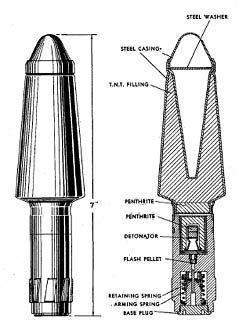 This grenade, while larger and of slightly different contour than that described on the preceding page, is basically the same in construction and operation. The body of pressed steel contains a steel cone around which the T.N.T. filler is cast, and at the bottom of the filler is an exploder pellet of penthrite wax. Two types of stem may be used, one entirely of light alloy and the other of plastic with a steel shank by which it is screwed onto the body. The booster assembly and the percussion type fuze are both located in the stem divided by a perforated septum which contains a small flash pellet. At the base of the stem is a rifled band which corresponds to the rifling on the discharger. The assembly is closed by a base plug.
This grenade, while larger and of slightly different contour than that described on the preceding page, is basically the same in construction and operation. The body of pressed steel contains a steel cone around which the T.N.T. filler is cast, and at the bottom of the filler is an exploder pellet of penthrite wax. Two types of stem may be used, one entirely of light alloy and the other of plastic with a steel shank by which it is screwed onto the body. The booster assembly and the percussion type fuze are both located in the stem divided by a perforated septum which contains a small flash pellet. At the base of the stem is a rifled band which corresponds to the rifling on the discharger. The assembly is closed by a base plug.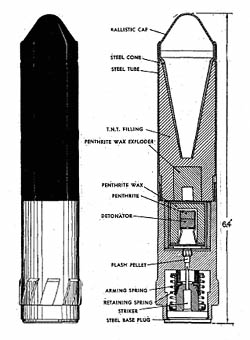 The Gewehr Panzergranate is constructed in two parts, the head and the stem. The head, a seamless steel tube fitted with a light ballistic cap, contains a hollow charge cone and an explosive filling of T.N.T. A cavity is provided in the rear portion of the main filling to take an exploder of penthrite wax. The stem of light alloy or aluminum is screwed onto the head of the grenade. It is divided into two compartments. The upper portion contains the booster which consists of a detonator surrounded by a penthrite wax filling contained in a light alloy case. The percussion type fuze is located in the lower part of the stem. In the septum is a small flash pellet held in place by a perforated screw plug. A pre-engraved driving band is formed on the outside of the grenade approximately 1/4 inch fromn the base. The entire assembly is closed by a base plug which positions the fuze by a stem which fits into a recess in the rear of the striker body.
The Gewehr Panzergranate is constructed in two parts, the head and the stem. The head, a seamless steel tube fitted with a light ballistic cap, contains a hollow charge cone and an explosive filling of T.N.T. A cavity is provided in the rear portion of the main filling to take an exploder of penthrite wax. The stem of light alloy or aluminum is screwed onto the head of the grenade. It is divided into two compartments. The upper portion contains the booster which consists of a detonator surrounded by a penthrite wax filling contained in a light alloy case. The percussion type fuze is located in the lower part of the stem. In the septum is a small flash pellet held in place by a perforated screw plug. A pre-engraved driving band is formed on the outside of the grenade approximately 1/4 inch fromn the base. The entire assembly is closed by a base plug which positions the fuze by a stem which fits into a recess in the rear of the striker body.